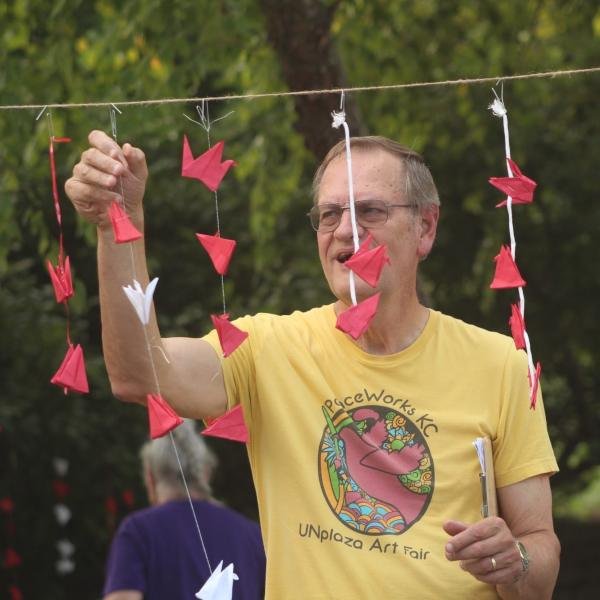By Keiko Baker
During the Hiroshima/Nagasaki Remembrance, Keiko Baker, the honorary principal of the Japanese School in the Kansas City area, shared—for the first time in public—her memories from living in Japan in 1945 and the impact of the Nagasaki bomb on her and her family.
I have been asked to speak about my experiences with the atomic bomb that was dropped on Nagasaki, Japan, on Aug. 9, 1945. At that time, I was in Saga, Japan, about an hour and a half outside of Nagasaki. It was hot, and we were outside chatting with neighbors. All of a sudden, just after 11 am, I saw a bright light shoot sideways across the sky. “What was that?” we all wondered. It wasn’t raining. There wasn’t any thunder following the bright light.
Two days later, my aunt and uncle wanted to go to Nagasaki to look for our cousin. He was there going to the university. They had heard that a new type of bomb had been dropped on Nagasaki, and they were very worried about their son. I hopped on the back of a small, three-wheeled truck with my aunt, uncle, and two neighbor children. As we neared the city, we saw more and more people heading in that direction. When we arrived, we were shocked to see this beautiful valley, surrounded by mountains, once a thriving city, completely flat and smoking. There was a grid of streets, but no more buildings. The sky was dark and full of ash. My aunt and uncle didn’t recognize anything and didn’t know where we were.
What we saw, words cannot describe. People were huddled together, some were calling for loved ones, others seemed lost. It was hard to understand what we were seeing. They looked like they were covered in mud. They were charred, burnt, their bodies blackened, their skin loose and hanging, their hair was the color of ash. Many were moving toward the river, looking for water. Muddy, bloody, and burnt; that is the image still clear in my mind. They didn’t look like humans.
My aunt and uncle dropped us off in the safest place they could find and told us to stay and wait so that we didn’t have to see more. When they returned, their faces were very sad. They said there was no way to find their son. He had disappeared. We didn’t say anything on the way home. We didn’t understand what we saw or how we felt. We didn’t know what we would tell everyone. When we returned home and tried to explain what we saw, my mother asked, “How many bombs did they drop?”
“One,” we answered. It took some time for that to sink in.
I was 13 years old at the time, spending a couple of hours each day out of the classroom working in a factory to make soldiers’ uniforms. The war ended 6 days after Nagasaki and its people suffered total devastation. Seventy thousand people died for nothing, I thought.
Years later, in 1960, I got married in Sasebo, Japan, and then came to the US. In 1964, we went to Hawaii. There I saw the atomic bomb again. They were testing the bomb on a nearby island in the Pacific and broadcasted a warning so that people would not be afraid. Weather postponed the event a couple of times. Then one evening we were watching TV, and I saw the sideways flash of light again, outside the window.
I said to my husband, “They did it.”
“They did what?”
“They dropped the bomb.”
I would never forget that sideways flash. It lit up the whole city of Honolulu. Everyone in the apartment complex rushed outside to see it. Some people were saying how beautiful it was, the clouds bathed in orange, but others said the sky was the color of blood. All I could think was I can’t believe they’re still testing that bomb. I thought they would never do this inhuman act again. But there it was.
Quickly, I learned not to say anything. I didn’t want my American friends to feel bad about it, so I didn’t talk to anyone about what I had seen or how I felt. In 1964, I found a nodule growing on my throat. My friend and neighbor, a doctor who knew I had been in Nagasaki, suggested I go see an endocrinologist. During my visit, the doctor told me about children with tonsillitis being treated with radiation, resulting in thyroid cancer. He was concerned that I might have the same fate because of the nuclear fallout I was exposed to in Nagasaki. He removed half of my thyroid for examination, and thankfully the nodule was benign. When an American friend came to see me in the hospital, she said, “After 20 years, that’s not fair for you.” But I was American, too, and I didn’t think it was fair for her to feel bad about it.
In 1974, we moved to Kansas. I started having nodules again. They did further exploratory surgery, removing more of my thyroid. I will have to take thyroid medication for the rest of my life, but that is nothing compared to how so many suffered. I don’t blame American citizens for this tragic event; it was the result of warring countries.
The bomb was made by humans, dropped by humans, and suffered by humans, and that is no way to resolve conflict. It is an utter devastation of precious human lives. It is my wish that we never use an inhuman weapon like this ever again, anywhere on this earth.

